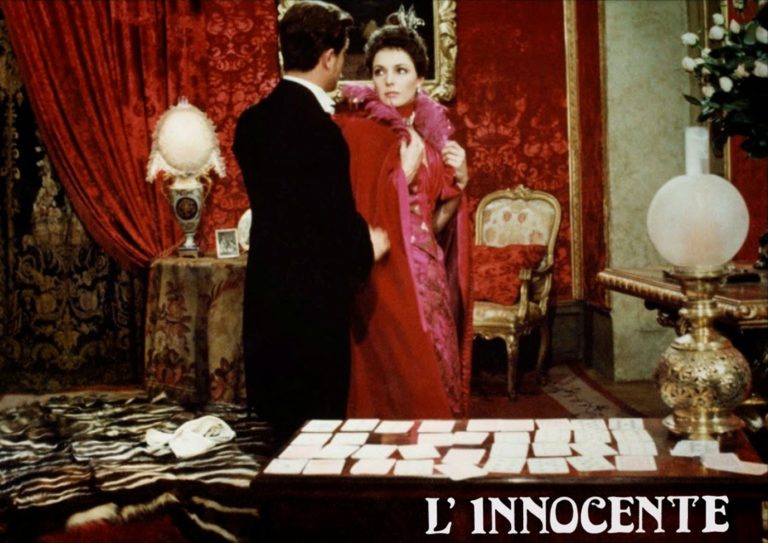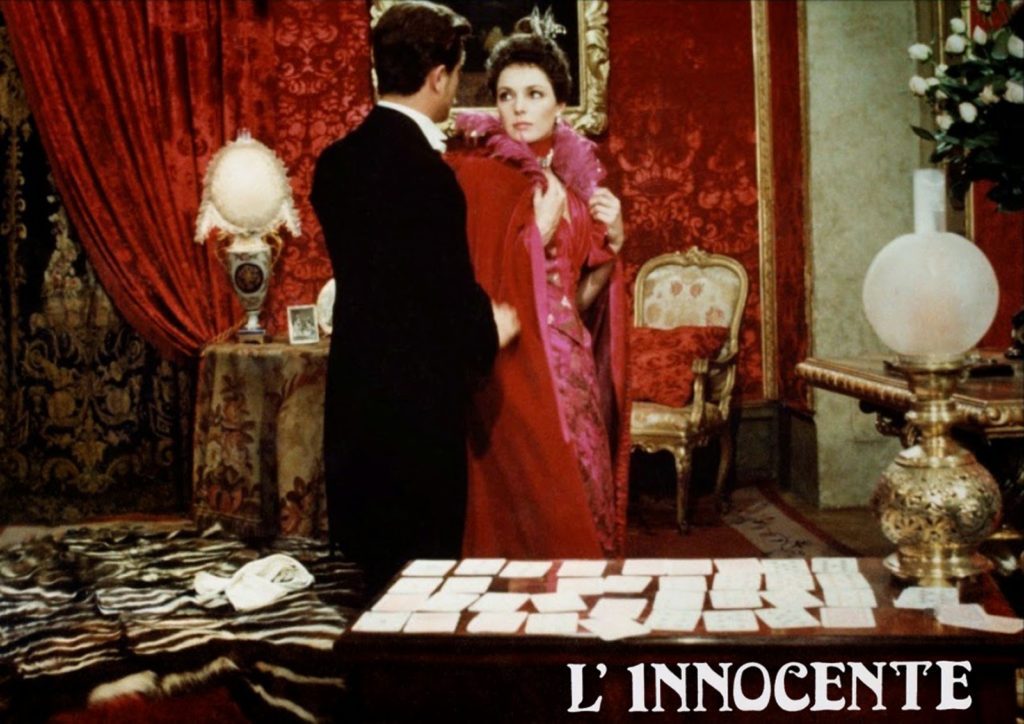
Currently on a limited run at Manhattan’s Film Forum, “L’Innocente” (1976) by Luchino Visconti is a portrait of a married couple eaten alive by traditional institutions both domestic and societal, soaking in the lushness of Latin lust and melodrama within 19th century Roman aristocracy.
This, the last motion picture by Visconti, himself a count in a noble family dating back to medieval Milan, is not only feminist, but humanist; striving to find the value of human choices through a presumptive free will of the soul within man-made constraints inherent to class, marriage, and religion. It has the audacity to showcase hot marital sex as a fight for freedom, or at least a reclamation of intent, between a husband and wife for whom it might be too late, if certainly not too little.
The bravura opening scene is a positing of a husband’s male privilege as antagonist to the dignity of his wife who must endure the humiliation of attending the same operatic performance as his mistress. One might initially take Giancarlo Giannini’s Signor Tullio Hermil as a Lothario taking on the burden of juggling wife and mistress in a manner mutually respectful to both. He is, in fact, an atheist who holds himself accountable to this world, expecting neither punishment nor absolution in the next. This does have the ring of not just personal responsibility, but dare one suggest, hope, felt by a man who believes he is subject to neither punishment nor praise from a higher power, but rather, to the immediate affect he has on his fellow travelers, and they on him; above all, his wife, la Signora Giuliana played by Laura Antonelli.
The opening operatic performance showcases husband and mistress in a feud over propriety, neither having warned the other of their impending attendance, while the wife has little choice but to suffer silently in the middle of a crowd whose eyes may be in the direction of the stage, but are, no doubt, on her. Tullio’s attempt to mitigate this scene loses its place of prominence to the inner strength of Giuliana who is magnificent and unmoved, framed with a restrained stoicism indicative of the Ancient Roman virtues of dignitas and gravitas.
The mistress, a wealthy widow with freedom denied most women thanks to the independence of her own finances, has all the fun that comes with unencumbered mobility in both the bedroom and the salon. She seems almost trite in comparison to the wife who is magnanimous precisely because she cannot, will not, move. Tullio, it turns out, takes Giuliana seriously enough to be honest and forthright about his infidelities, accepting as due course his right to adultery and his duty to at least respect her face to face if not body to body.
Of course, he finds himself desiring her insurmountably once it’s evident that she has taken a lover of her own – a novelist whose mustache resembles that worn by Italian screenwriter, poet, playwright, journalist, politician, and war pilot Gabriele D’Annunzio, whose 1892 novel the motion picture is adapted from, and who at the close of World War I occupied the Italian city of Fiume with a couple thousand troops, declaring it a sovereign nation whose constitution claimed its official language to be music. An iconoclast if there ever was one, the Vatican put the works of D’Annunzio on its index of forbidden literature.
Though her affair reignites Tullio’s lust for her, Giuliana’s own feelings are more vague than was her obvious torment at being cheated on, and the predicament she now finds herself in, facing the biological and institutional consequences of being another man’s married lover. Whether Tullio’s newly-found determination to have her might be born of any sort of benevolence, or whether it’s even something she feels worthy of re-kindling, are beside the point. Claiming center stage is a new burden of responsibility shared by both spouses as parents in a quagmire of their own creation. Giuliana’s subservience per her gender victimizes her to Tullio’s power of sovereignty inherent in his, but it is he, more than she, who ultimately succumbs to the dangers of navigating those very parameters when, exploit them all he might, he simply didn’t believe in them in the first place.
Like Visconti’s “The Leopard” (1963), “L’Innocente” exudes a decadence of lifestyle and aristocratic norms whose death knell started with the Italian independence and unification movement known as Il Risorgimento in the 1860’s, and which would die throughout Europe come World War I. During the 1890’s in which this picture takes place, Italy was at the tumultuous apex of banking scandals both in Rome and Sicily, as well as state-sanctioned violence against the Fascio labor movement – the fascio being the bundle of wooden rods that was the symbol of Ancient Roman diplomatic power and solidarity. The turn-of-the-century, Sicily-based, labor movement that took its name was grounded in the patriotism and humanitarian Christianity (which should have been a redundant term) as Il Risorgimento had been, now demanding basic rights of workers that anyone in today’s America would take for granted. In 1893 it would be crushed; from within by Mafia infiltration – mafiosi having ostensibly joined the movement to give it teeth only to undermine it by assuming the jobs the movement’s workers were striking from – and from without by Prime Minster Francesco Crispi, himself Sicilian, choosing to confront the situation by inflicting military violence on his own people under the absurd ruse of a conspiracy between the Fasci socialists and the Vatican which was, at the time, an enemy of a united Italy.
Left largely untouched, were the bankers and politicians – both federal with ties to state funds, and local with ties to Mafia – using the people’s institutions to enrich themselves, or as in the case of the king himself, using bank fraud as a means to pay off his mistresses.
And so, the hierarchy depicted in “L’Innocente” would epitomize the failure of Il Risorgimento to live up to the ideals of its founders as a movement to regain Italy’s autonomy from the peninsula’s foreign occupiers for the first time since Ancient Rome with the intent to turn inward toward the nest of our indigenous Latin culture and the humanistic virtues of our ancients, revived fleetingly during the Renaissance. Instead, the powers that be went on to exploit the newly-founded institutions of the young nation state, and were determined to pursue a foreign policy focused on the disastrous attempt to catch up to the colonialism of the rest of Europe; all one hell of a mess with which to face the challenges yet in store at the dawn of the 20th century.
The wonderful quality of D’Annunzio’s literary body of work was to distill the unmatched history of Italy – with more millennia than America has centuries, and which was for so long a culture in search of a country – through the personal lives of characters and their narrow predicaments. It made our glorious, tragic, world-shaping history and rebirth an eternal hope for a future that would come crashing down with the new mid-20th century Fascists’ betrayal of our ancient virtues, which, despite requisite military prowess to back them up, were in fact the benevolent framework for modern democracy itself; ironic and tragic, that it was largely lost on the Italians.
Who better to formulate this on a cinematic canvas then Visconti, a lapsed member of an aristocracy that suddenly found itself incompatible with modern society. But for the time being, D’Annunzio wrote the picture’s source material in the thick of Italy’s past arriving at its potential, while Visconti and his co-adapter, legendary screenwriter Suso Cecchi D’Amico, came of age sorting out the pieces among the ruins of the country’s mid-20th century collapse and the impressive economic ascendancy of its post World War II future amid the Pax Americana.
As the director of “Obsession” (1943), which was the first cinematic adaptation of “The Postman Always Rings Twice”, James M. Cain’s story of extra marital romance turned murderous, as well as “Rocco and His Brothers” (1960), about southern Italian peasantry trying to get a piece of the industrial pie in a modern democratic and capitalist Italy, and as a writer of neorealist landmarks such as Rossellini’s “Rome – Open City” (1945) and De Sica’s “Bicycle Thieves” (1948), Luchino Visconti and Suso Cecchi D’Amico, respectively, were just the male and female tandem to bring Gabriele D’Annunzio’s aesthetic exploration of Italian culture’s classic virtues and modern vices to metaphorical terms with the way it all turned out – at times chaotic and contradictory, continuing through modernity perhaps without a hoped-for philosophical center of gravity, but with unrivaled passion, despite the torment of it all.
ABOUT GIÒ CRISAFULLI:
Giò Crisafulli is the Chief Entertainment Critic for NOIAFT and writer/director of “Children of God” which he is producing with Melissa Batista at Zio Ciccio Cinema, in which an actor who’s the son of a priest and nun is on the verge of stardom while having an affair with a painter from Italy. A sensational and intuitive look into the romance of two people, it will show how any relationship can be a fleeting microcosm of one’s life.
Check out Giò’s interviews at Lincoln Center’s Opens Roads New Italian Cinema:




I just had a chance to sit down with your article on L’INNOCENTE. I appreciate your skill at making your subject come vividly to life, and your willingness to go deep.. I refer not only to the film itself, but also your seemingly encyclopedic command of Italian history and cultural nuances. Thanks for a great read.